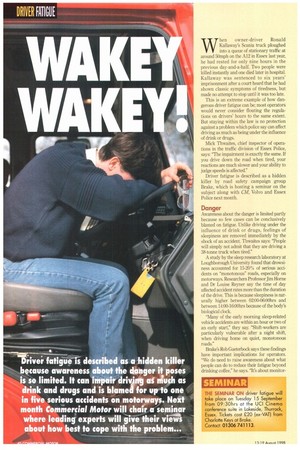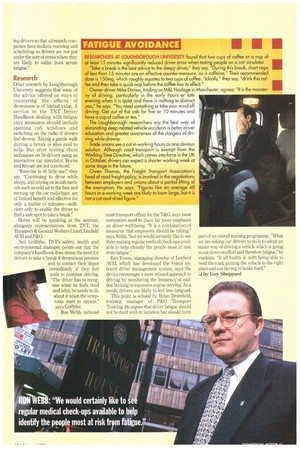DRIVER FATIGUE river fatigali described as a hidden killer because
Page 42

Page 43

If you've noticed an error in this article please click here to report it so we can fix it.
awareness about the danger it poses is so limited. It can impair driv,inga niuch as drink and drugs and is blamei for up to one in five serious accidents on motorways. Next month Commercial Motor will chair a seminar where leading experts will give their viegt
about how best to cope with the problem...
When owner-driver Ronald Kaliaway's Scania truck ploughed into a queue of stationary traffic at around 50mph on the Al2 in Essex last year, he had rested for only nine hours in the previous day-and-a-half. Two people were killed instantly and one died later in hospital. Kallaway was sentenced to six years' imprisonment after a court heard that he had shown classic symptoms of tiredness, but made no attempt to stop until it was too late.
This is an extreme example of how dangerous driver fatigue can be; most operators would never consider flouting the regulations on drivers' hours to the same extent. But staying within the law is no protection against a problem which police say can affect driving as much as being under the influence of drink or drugs.
Mick Thwaites, chief inspector of operations in the traffic division of Essex Police, says: "The impairment is exactly the same. If you drive down the road when tired, your reactions are much slower and your ability to judge speeds is affected."
Driver fatigue is described as a hidden killer by road safety campaign group Brake, which is hosting a seminar on the subject along with CM, Volvo and Essex Police next month.
Danger
Awareness about the danger is limited partly because so few cases can be conclusively blamed on fatigue. Unlike driving under the influence of drink or drugs, feelings of sleepiness are removed immediately by the shock of an accident. Thwaites says: "People will simply not admit that they are driving a 38-tonne truck when tired."
A study by the sleep research laboratory at Loughborough University found that drowsiness accounted for 15-20% of serious accidents on "monotonous" roads, especially on motorways. Researchers Professor Jim Home and Dr Louise Reyner say the time of day affected accident rates more than the duration of the drive. This is because sleepiness is naturally higher between 02:00-06:00hrs and between 14:00-16:00hrs because of the body's biological clock.
• "Many of the early morning sleep-related vehicle accidents are within an hour or two of an early start," they say. "Shift-workers are particularly vulnerable after a night shift, when driving home on quiet, monotonous roads."
Brake's Rob Gueterbock says these findings have important implications for operators. "We do need to raise awareness about what people can do to reduce their fatigue beyond drinking coffee," he says. "It's about monitor ing drivers so that ultimately companies have realistic routeing and scheduling so drivers are not put under the sort of stress where they are likely to suffer from severe fatigue."
Research
Other research by Loughborough University suggests that some of the advice offered on ways of countering the effects of drowsiness is of limited value. A section in the TNT Driver Handbook dealing with fatigue says measures should include opening cab windows and switching on the radio if drivers feel drowsy Taking a gentle walk during a break is also said to help. But after testing these techniques on 16 drivers using an interactive car simulator, Horne and Reyner are not convinced.
"Exercise is of little use," they say. "Continuing to drive while sleepy, and relying on in-cab methods such as cold air to the face and turning up the car radio/tape, are of limited benefit and effective for
only a matter of minutes sufficient only to enable the driver to find a safe spot to take a break."
Horne will be speaking at the seminar, alongside representatives from TNT, the Transport & General Workers Union, Leafield AVM and P&O.
Neil Griffiths, TNT's safety, health and environmental manager, points out that the company's handbook does stress the need for drivers to take a break if drowsiness persists and to contact their depot immediately if they feel unfit to continue driving. "The driver has to recognise when he feels tired and what he needs to do about it when the symptoms start to appear," says Griffiths.
Ron Webb, national road transport officer for the T&G, says most companies need to place far more emphasis on driver well-being. "It is a combination of measures that employers should be taking," says Webb, "but we would certainly like to see them making regular medical check-ups available to help identify the people most at risk from fatigue."
Ken Evans, managing director of Leafield AVM, which has developed the Vemis onboard driver management system, says the device encourages a more relaxed approach to driving by monitoring the frequency of sudden braking or excessive engine revving. As a result, drivers are likely to feel less fatigued.
This point is echoed by Brian Bromfield, training manager of P&O Transport Training. He argues that driver fatigue should not be dealt with in isolation but should form part of an overall training programme. "What we are asking our drivers to do is to adopt an easier way of driving a vehicle which is going to cut down on effort and therefore fatigue," he explains. "It all builds in with being able to read the road, putting the vehicle in the right place and not having to brake hard."
0 by Guy Sheppard
FATIGUE AVOIDANCE
RESEARCHERS AT LOUGHBOROUGH UNIVERSITY found that two cups of coffee or a nap of at least 15 minutes significantly reduced driver error when testing people on a car simulator. "Take a break is the best advice to the sleepy driver," they say. "During this break, short naps of less than 15 minutes are an effective counter-measure, as is caffeine." Their recommended dose is 150mg, which roughly equates to two cups of coffee. "Ideally," they say, "drink this coffee and then take a quick nap before the coffee has its effect," Owner-driver Mike Davies, trading as M&L Haulage in Manchester, agrees: "It is the monotony of driving, particularly in the early hours or late evening when it is quiet and there is nothing to distract you," he says. "You need something to take your mind off driving. Get out of the cab for five or 10 minutes and have a cup of coffee or tea."
The Loughborough researchers say the best way of eliminating sleep-related vehicle accidents is beer driver education and greater awareness of the dangers of driving while drowsy.
Trade unions see a cut in working hours as one obvious solution. Although road transport is exempt from the Working Time Directive, which comes into force in the UK in October, drivers can expect a shorter working week at some stage in the Future. Owen Thomas, the Freight Transport Association's head of road freight policy, is involved in the negotiations between employers and unions about a partial lifting of the exemption He says: "Figures like on average 48 hours in a working week are likely to loom large, but it is not a cut-and-dried figure."
SEMINAR
THE SEMINAR ON driver fatigue will take place on Tuesday 15 September from 09:30hrs at the UCI Cinema conference suite in Lakeside, Thurrock, Essex. Tickets cost 220 (ex-VAT) from Charlotte Keys at Brake. Contact: 01306 741113




































































































